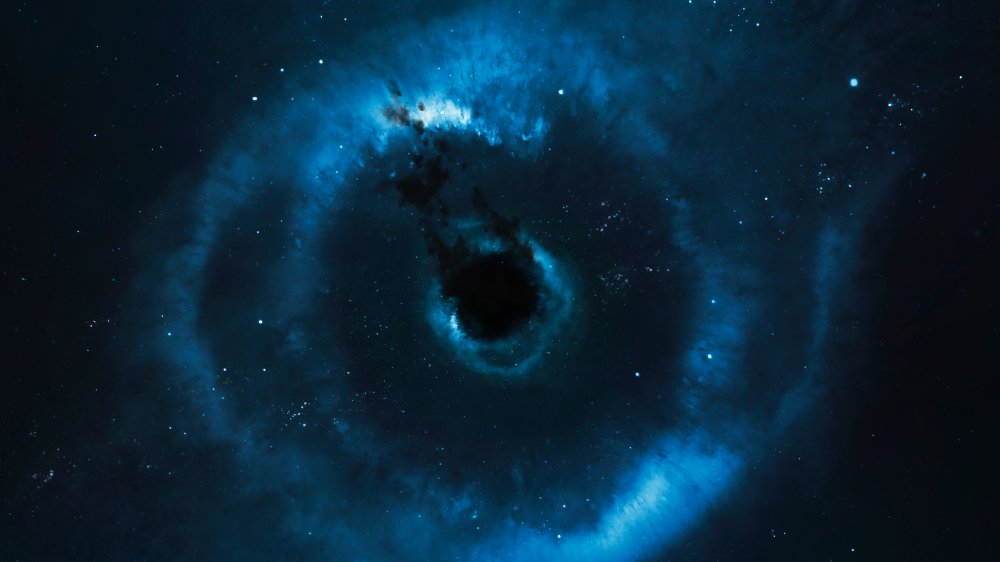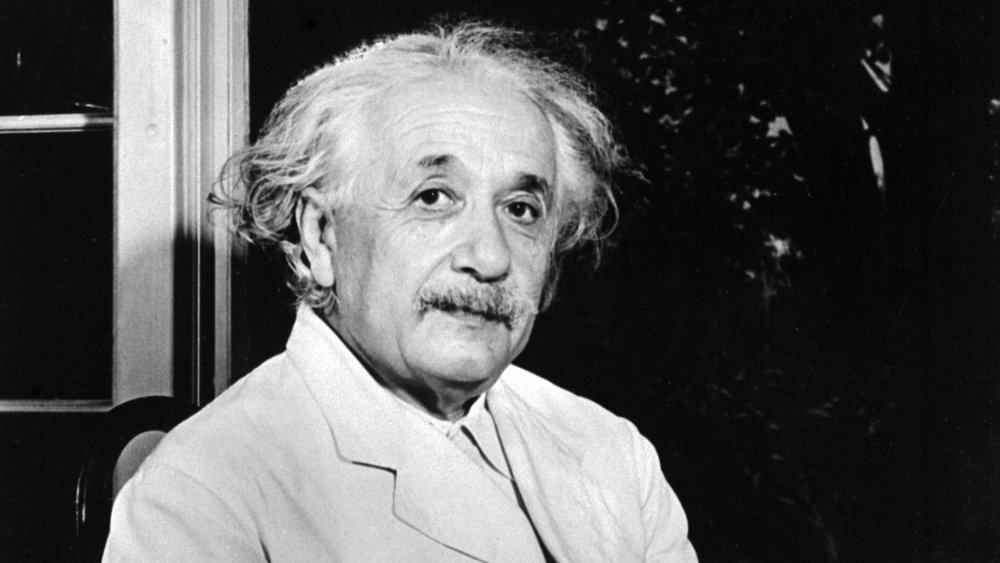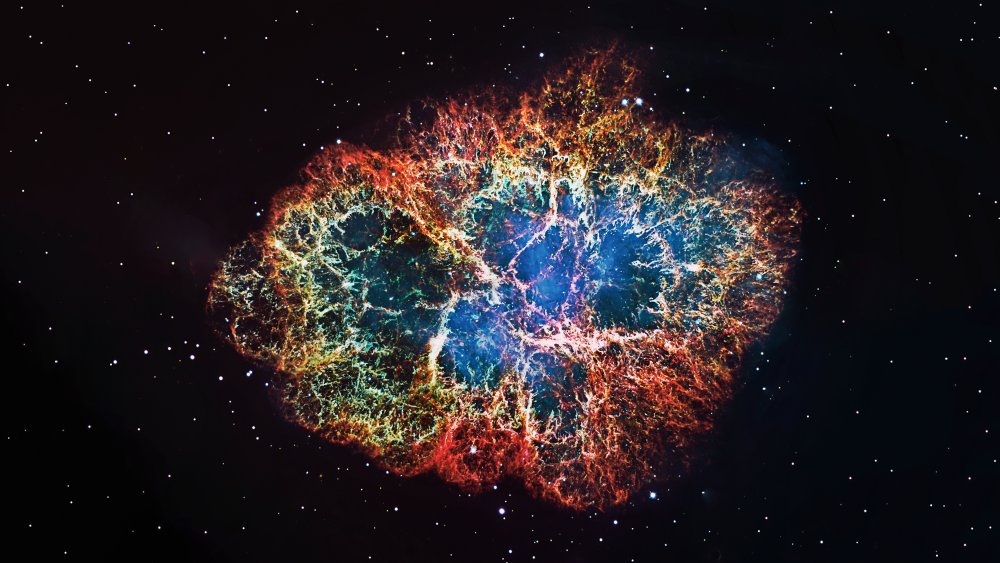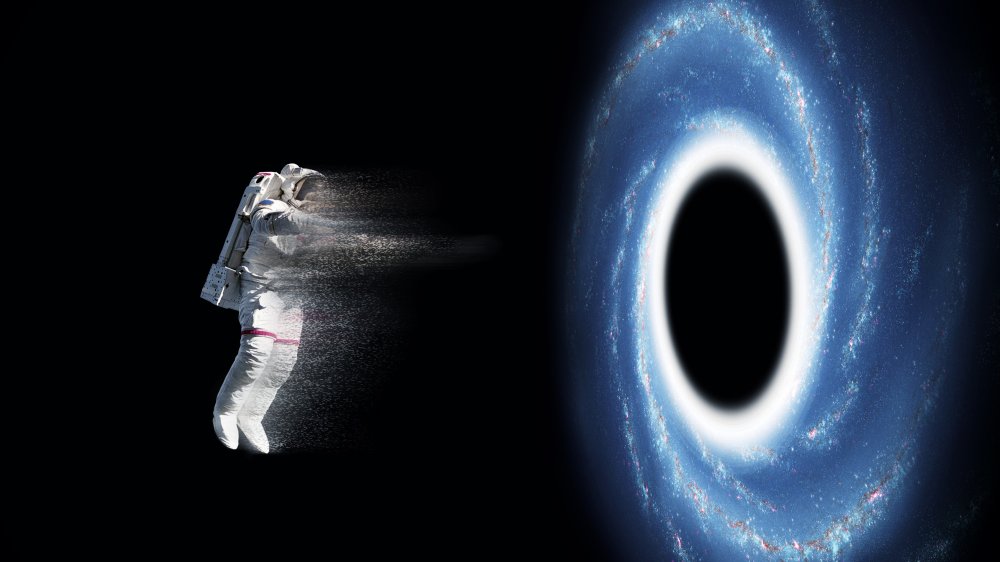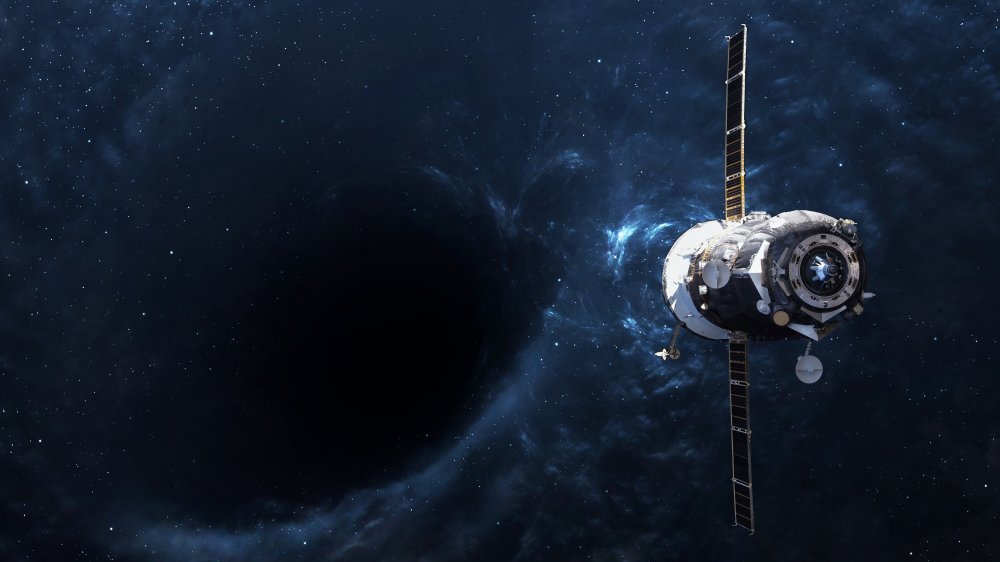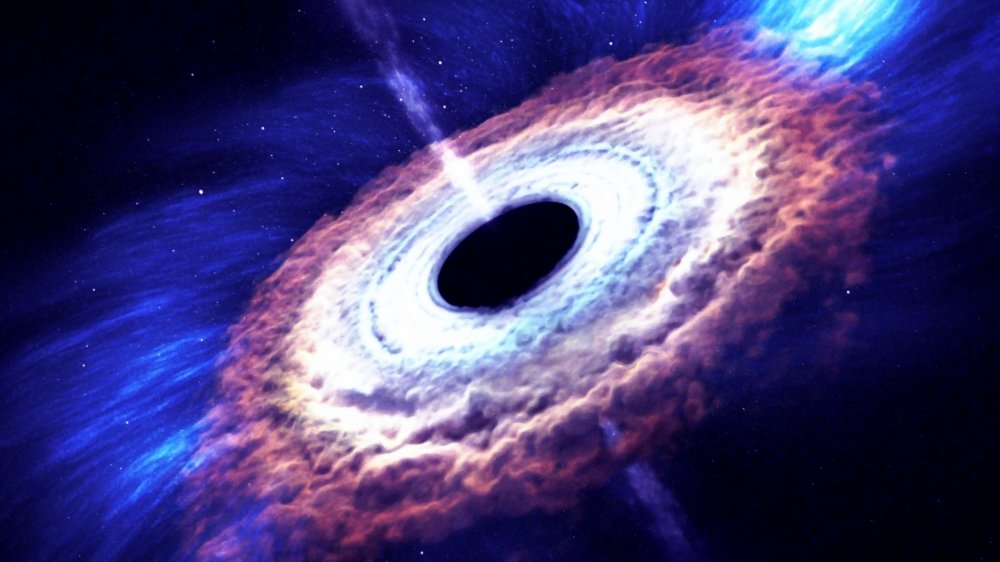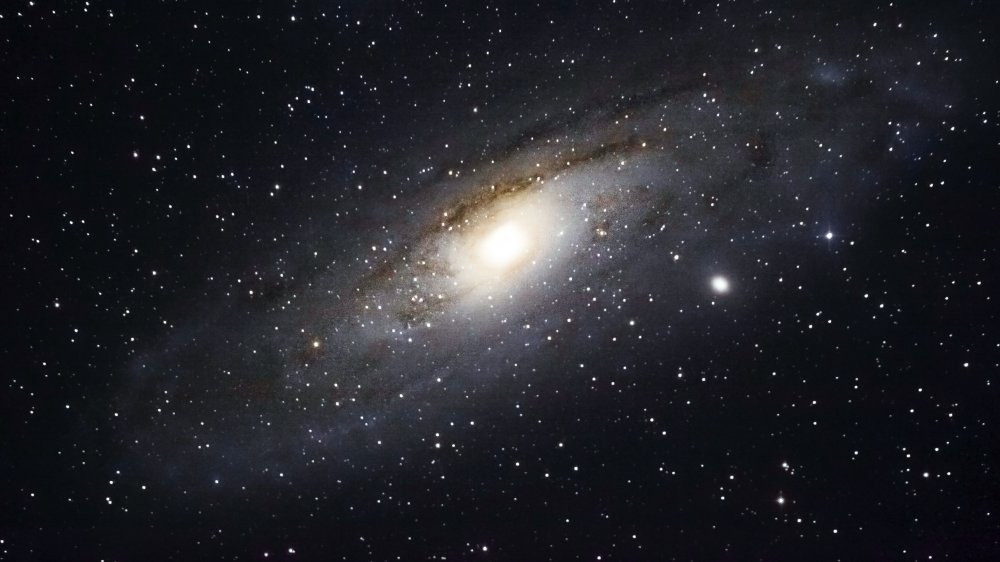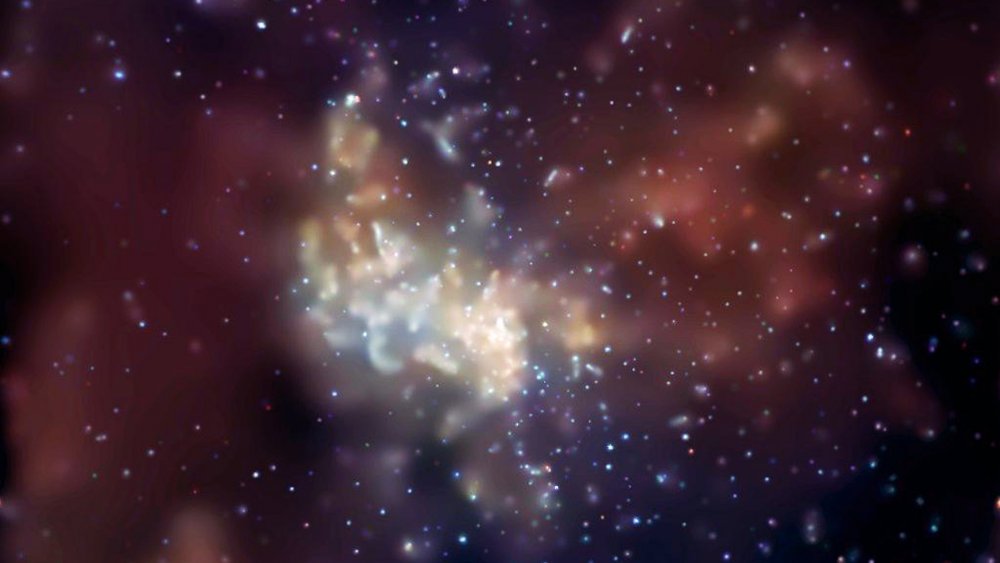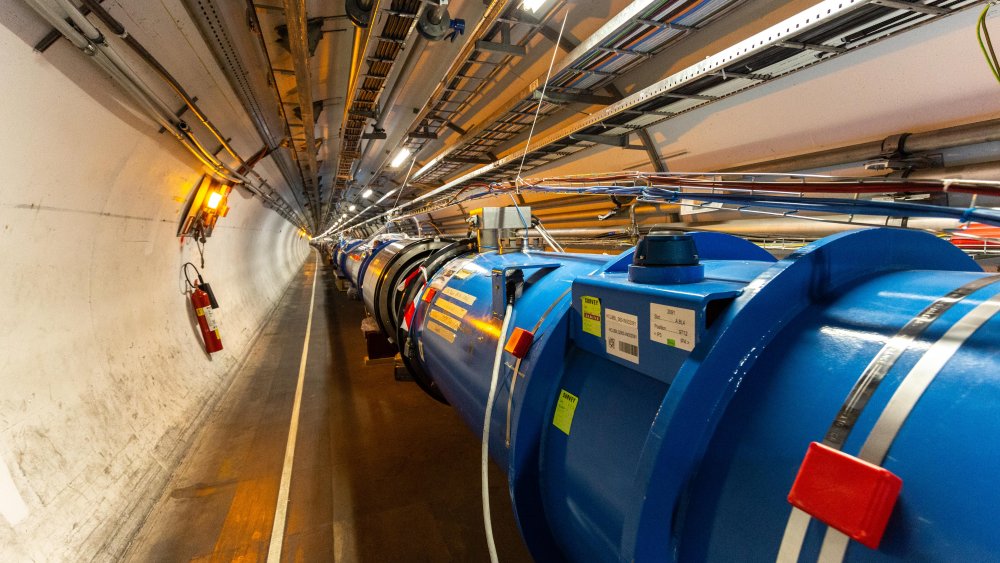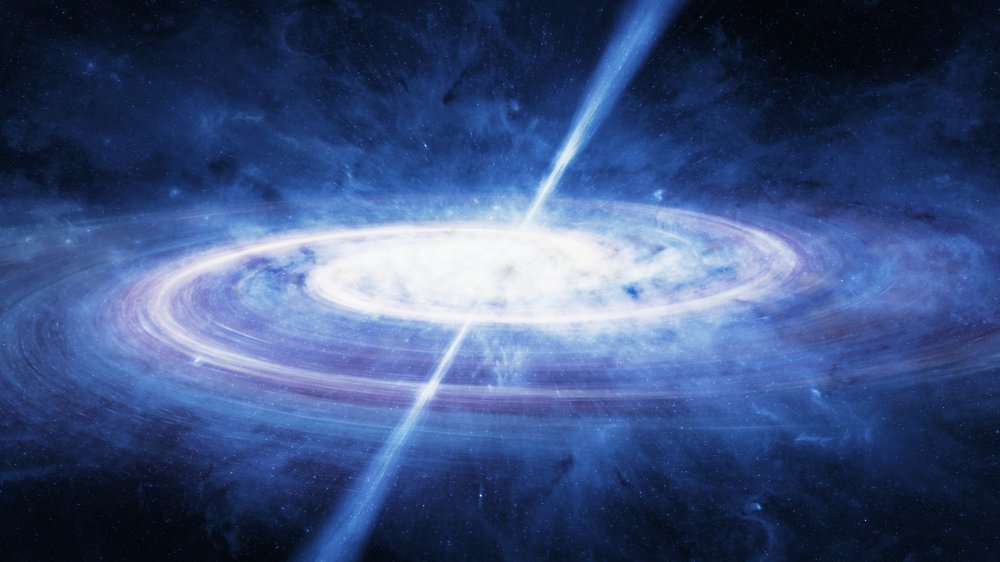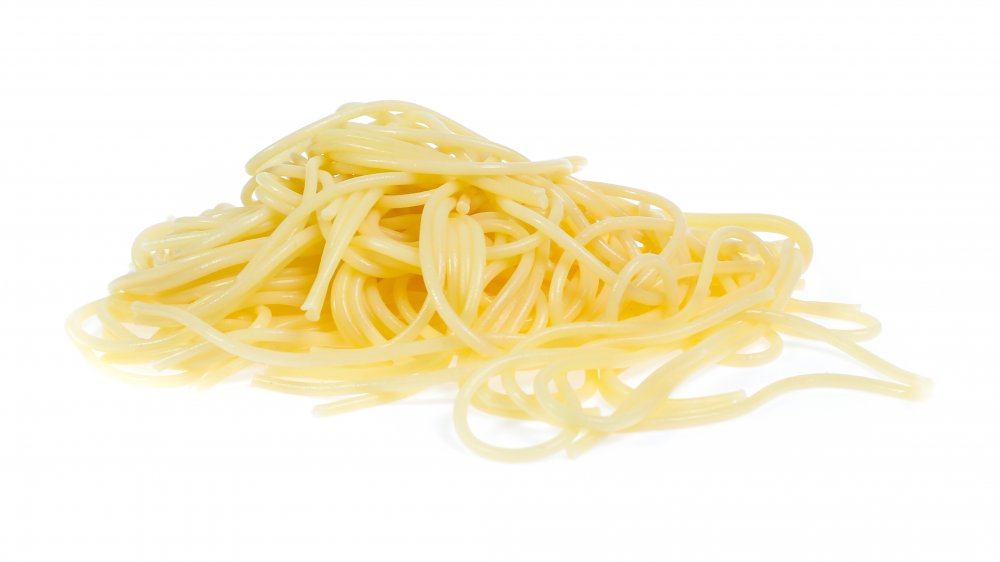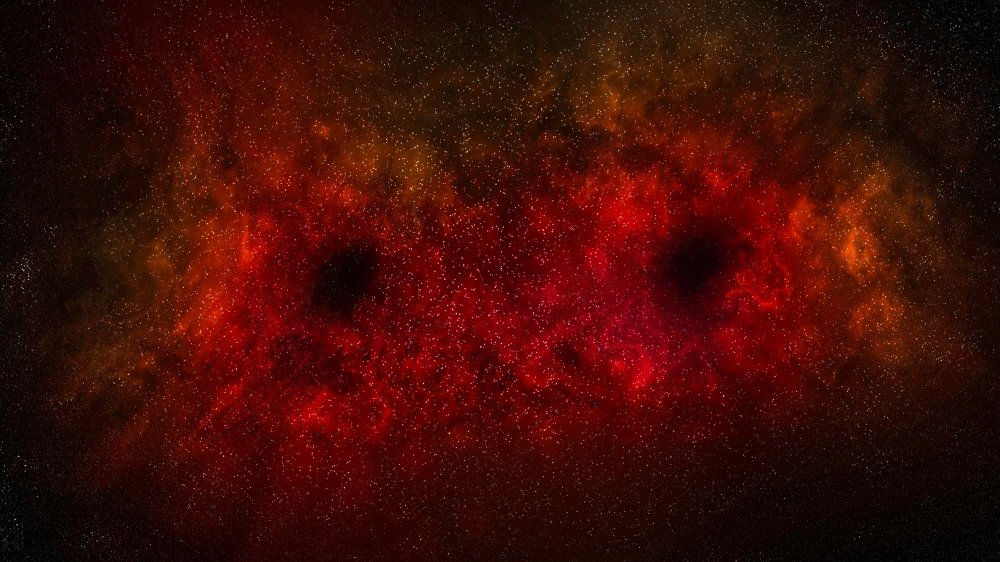The Untold Truth Of Black Holes
Everyone knows black holes are basically just giant, inescapable, eternally flushing cosmic toilets. If you get caught in that terrible suction, you end up somewhere else — only instead of a gross interstellar sewage system, there's a wonderful world of alternate timelines, parallel universes, and hopefully, unicorns. How do we know this? We know this because it is what Hollywood hath taught us, and Hollywood knoweth all.
Well, sorry to burst your interdimensional dark matter bubble or whatever, but Hollywood has got it all wrong. Yes, pretty much all of it. Black holes are nothing like they've been depicted in science fiction, and there are no unicorns on the other side, and you also probably won't find Matthew McConaughey in one, either. Sorry. But the good news is that black holes don't need Hollywood to be simultaneously terrifying and also really, really cool. They just need an interdimensional dose of the cold, spaghettified truth. Here you go.
Einstein was talking about black holes before they were cool
Black holes are such a crazy notion that you might be tempted to assume we only know about them because someone was looking out into deep space and went, "Holy crap, what's that? We're all gonna die!" But that's not how it happened. No, black holes were a bizarre theory long before their existence was confirmed, and the idea rose from Albert Einstein's theory of relativity.
According to Einstein's theory, space and matter interact kind of like a flat sheet of rubber with a bowling ball on it. The rubber bends under the weight of the bowling ball, so smaller objects will roll towards the bowling ball, not because the ball itself has some mysterious attractive force but because they're following the dip in the sheet of rubber. However, it wasn't Einstein himself that made the leap from that theory to the idea of black holes — it was German physicist Karl Schwarzschild, who realized that if a body was heavy enough, the speed another object would have to attain to escape its gravity would be greater than the speed of light.
According to Scientific American, though, Einstein himself disliked the idea of black holes, and he even published a paper in 1939 that he clearly hoped would dismantle the idea once and for all. But even Einstein couldn't make black holes go away, and in 1971, astronomers discovered the first clear evidence that Schwarzschild had been right all along. Eek.
What exactly is a black hole anyway?
Black holes are basically the exact thing that Karl Schwarzschild described that freaked Einstein out so much he tried to explain them away as impossible. They're bodies so heavy that nothing can escape their gravitational pull, not even light. But how exactly does an object become that massive? An out of whack pituitary gland, perhaps? Chick-fil-A for breakfast, lunch, and dinner?
Actually, according to Discover, the most probable route from benign object to super terrifying black hole starts with a dying star. When a large star runs out of fuel, it collapses, which causes the outer layers to explode in what we all know as a supernova. As the core continues to collapse, it gains mass, and eventually, a very, very heavy core — about three times the size of our sun — will become so massive that nothing will be able to get away from its gravitational pull.
Massive may not mean what you think it means, though. In this sense, massive refers to the weight of the object, not its size. So black holes can be extremely massive yet unfathomably tiny, and that's what makes them so powerful, bizarre, and terrifying.
Black holes have two parts
Once a star is on its way to becoming a black hole, there's pretty much no stopping it. According to Discover, the core of the giant star continues to collapse, getting smaller and smaller until it's really, really tiny. Not mouse tiny or even bumblebee tiny, but smaller than an atom tiny. Smaller than an electron tiny. In fact, the core — known as a "singularity" — eventually shrinks down to the smallest unit that's possible to measure. Physicists call this a "plank length," which is roughly 100 quintillionth the size of a proton.
So the "hole" as we think of it — that part that Hollywood spaceships are always getting sucked into — isn't the part where all of the mass resides. Instead, it's simply the point of no return or the line you don't want to cross. Called "the event horizon," once you step into it, you're doomed. There's no turning back, there's no escape, you're officially a victim of the black hole.
The event horizon isn't a hole, though, despite the persistence of the name. It's not a funnel, either, nor is it toilet-bowl shaped. The event horizon is actually shaped like a sphere, which makes black holes kind of the opposite of holes. So contrary to that story you wrote in the fourth grade, you cannot evade a black hole by flying under it, because black holes are a full 360 degrees of inescapable death.
Why do black holes suck?
Why do black holes suck? That's an easy one. Black holes don't suck. Well, okay, if you get too close to one you'll probably at some point say to yourself, "Dang, this experience sucks," but technically speaking, you're not being "sucked" into that black hole. You're falling towards it, much like you would fall towards the ground if you jumped out of an airplane right here on Earth. A black hole has no suction, just like the ground has no suction.
In fact, objects that are approaching a black hole — as long as they haven't crossed the event horizon— aren't necessarily doomed to fall into it. According to Forbes, that's because the combination of intense gravity and the difference in size between the black hole itself and all the stuff headed towards it makes it a difficult target to hit. Up to 90 percent of the matter that approaches a black hole won't fall into it. Instead, it will accelerate and then get jettisoned back out into space, where it might eventually go on to become a new star. So good news! Just because you're too close to a black hole doesn't mean you'll wind up inside one. You'll still die, but at least you won't be doomed to spend eternity hanging out with Matthew McConaughey and listening to him wax poetic about his Lincoln.
Why is a black hole's gravity so intense?
So if a black hole is just matter that was once a star, why is the gravity of a black hole so much more powerful than the gravity of the star it came from? Well according to the YouTube series "Bad Astronomy," that's not even the right question. A black hole's gravity isn't actually any stronger than the gravity of a star with equal mass.
So why do planets orbit around a star without ever falling into it, but a black hole of equal mass consumes everything around it, including light? The answer has to do with the size of the sun vs. the size of that tiny little point in the center of the black hole. The black hole's singularity is 100 quintillionth the size of a proton, while a star of equal mass might have a diameter of several million miles. So the difference between the gravitational pull of a black hole and a star with equal mass really comes down to distance.
An object's gravitational pull increases the closer you get to it. But a huge star covers a lot of space, so you're never close enough to be subjected to the full potential force of its gravity. A black hole, on the other hand, is tiny, so you can get very, very close to all of that condensed mass, closer than you could ever get to the mass of a giant star.
There's more than one way to consume a spaceship
Science recognizes at least three different kinds of black holes. The first is a little easier to get your mind around — it's the type that forms inside a dying star. On the opposite end of the spectrum, there are supermassive black holes, which Space.com says are millions or even billions of times as massive as the sun, but they have a footprint that's roughly equal in diameter. Okay eek, that's terrifying, but supermassive black holes only exist in the far reaches of space, right? Wrong. Astronomers think there's probably one at the center of every galaxy, including our own.
No one is sure how supermassive black holes form, but there are a few theories. Maybe multiple black holes fall into each other, forming one supermassive black hole. Maybe they rise out of a cluster of dying stars. They might also form in a collapsing cloud of gas. And there's often a lot of dust and gas floating around near the center of a galaxy, which gives the supermassive black hole plenty of food and an infinite means to get bigger and more massive.
The third type of black hole is called an "intermediate" black hole. In size, it's somewhere between a stellar and supermassive black hole, and it may form after a chain-reaction style collision of multiple stars. Ultimately, though, as you're falling into one of these things, you're not going to care how big it is, so whatever.
Black holes aren't black
In Hollywood, a black hole is easy to see, because it's basically just a can of Vantablack paint in the middle of a star field. But according to Space.com, you can't actually see a black hole. A black hole doesn't look like anything because the singularity itself is too tiny to observe, and the event horizon is just a measurement. It's not made of matter so it's basically invisible. To find a black hole, scientists have to look for the radiation that's emitted as dust and gas are drawn towards the event horizon. Supermassive black holes can be even harder to spot because there's a lot of dust and gas around them, which makes that radiation hard to see.
Other clues to the presence of a black hole might include stars that appear to be orbiting nothing, accretion disks — which are flat sheets of dust and gas that might form around a black hole — or if scientists are lucky, unfortunate stars that are actually falling into the black hole. But the black hole itself will remain invisible, which basically just makes it the universe's most effective death trap.
About that supermassive black hole in the center of the Milky Way ...
If every galaxy has a supermassive black hole in the center, what does that mean for the fate of all galaxies? Are we all doomed to eventually fall into the supermassive black hole at the center of the Milky Way, which is ultimately doomed to fall into another nearby supermassive black hole, which will eventually collide with another black hole, until all the matter in the universe gets condensed down into that one little spec of supermassive mass and ... then what?
For now, we don't have to worry about that. Yes, there is a supermassive black hole in the center of our galaxy (it's called Sagittarius A*), but it doesn't appear to be doing a whole lot. Yet. According to Space.com, Sagittarius A* is surrounded by a magnetic field, which might be directing some — but not all — nearby matter away from the black hole. So whew, that's a relief. Well, it is if you ignore the part where, in August 2019, scientists watched the space around the black hole get 75 times brighter. Why? Possibly because it was gobbling up some gas from a star called S0-2, which has been on a 16-year elliptical orbit around the black hole. You know, as an appetizer for when it finally decides to start gobbling up the rest of us.
Let's make some black holes in a lab!
In case you're thinking it's only a matter of time before that black hole in the center of the galaxy turns you into a long, weird, strand of organic matter, you can take comfort in the fact that our galaxy's supermassive black hole is 26,000 light years away from Earth, and therefore not likely to mess up your life any time soon. But here's another reason for you to freak out. Scientists right here on Earth are trying to use the Large Hadron Collider (pictured) to create miniature black holes. According to Phys.org, they're doing it because they want to prove the existence of parallel universes, although we all know that it's really because they're mad scientists, and they're trying to destroy the universe because that's what mad scientists do.
The good news is, so far, scientists haven't had any luck detecting mini black holes, so there's no danger of you waking up in the middle of the night and finding yourself inexplicably drawn towards Switzerland. But even if scientists did create a mini black hole, it really wouldn't be a threat. That's because a mini black hole would be really, really hot — think the core of our sun hot plus another 42 zeroes. So a mini black hole would evaporate into the much cooler space that surrounds it almost immediately, long before it has a chance to turn the whole world into a tiny point near Geneva.
An actively-feeding black hole is like the opposite of black
Some black holes, like the one at the center of our galaxy, are quiet. Why? Because they're just biding their time, stealthily powering up to become giant, planet-eating, galaxy-destroying balls of death. However, other black holes are happily and shamelessly munching their way towards the end of the universe, and those black holes are the opposite of stealthy.
You may have heard that the brightest object type in the universe is a quasar, but you might not have known that a quasar is bright because it's actually a black hole. Yes, it's exactly the opposite of what you might expect from a black hole because black holes are supposed to be, you know, black.
A quasar, as it turns out, is a supermassive black hole like the one at the center of our galaxy, but the difference is that it's actively gobbling up matter. According to Astronomy, the matter that's been drawn to it but hasn't yet fallen inside forms an accretion disk around the black hole, which becomes super-heated and therefore so bright that it's actually brighter than the entire freaking galaxy that surrounds it. Don't worry, though, scientists think that quasars eventually turn off, after they're done consuming all the matter within a few million miles. That's a relief.
You can't get this kind of spaghetti at an Italian restaurant
Hollywood tells us that the journey into a black hole is a great adventure, and on the other side, you'll find bizarre and dangerous alternate realities, fantastic creatures, and Homer Simpson ("Treehouse of Horror VI"). And that's fun, but the truth is that there is no inside of a black hole because a black hole is just a very tiny, incredibly dense point in space. Also, if you fall into one, you'll die. There's nothing that you can do about that, either. You can't build a super-solid spacecraft to help you navigate the danger, you can't go in feet first with your toes pointed, and you can't take shelter in a big library like in the ending of Interstellar. In short, you can't do anything to save yourself because the black hole will destroy you before you even reach that infinitesimal little point in space.
So what happens to you on your way to the singularity? Well, astronomers call it "spaghettification," because obvious reasons. Yes, according to How Stuff Works, your body will get drawn out into an impossibly long, thin strand, like a piece of pasta. At some point, you'll eventually snap in half, and then both parts of you will keep on stretching out, and so on and so on, creating a bowl of space spaghetti, only you'll be much less delicious with a little garlic and some marinara sauce. The good news is, death will be pretty quick.
It's okay because black holes are rare ... right?
Fortunately, black holes aren't very common. Oh wait, this document from NASA says "are," not "aren't." Oops. Black holes are common. In fact they're kind of ridiculously common. More common than Canada geese, though not nearly as common as chickens, but that's not saying much since there are 18.6 billion chickens in the world, so.
In fact, there are something like 10 million to 1 billion stellar black holes in the Milky Way alone, which means black holes in our galaxy are about as common as the domesticated sheep is here on Earth. The good news is that unlike Earth, where the average human is likely to encounter a number of sheep over the course of a single lifetime, the Milky Way is freaking enormous — like 200,000 light years from end to end — so we're not especially close to any of those millions of black holes. In fact the closest black hole is roughly 3,000 light years from us, which means that even if the Earth suddenly started falling into it and even if we were traveling towards it at the speed of light, it would still take several thousands of years before our planet would become a plate of spaghetti for Matthew McConaughey.
